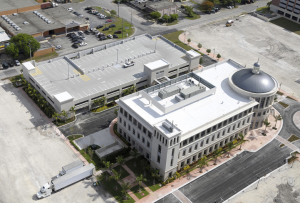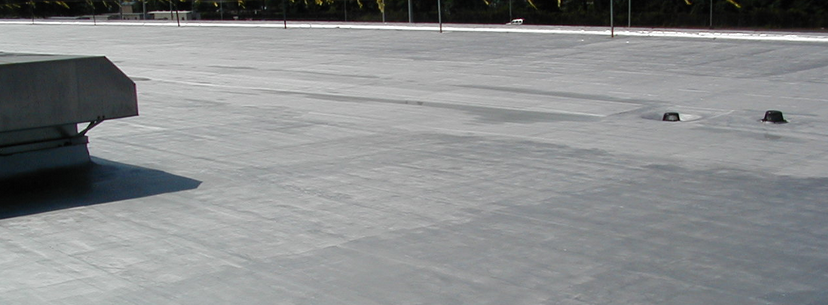Asphalt-based roof systems have a long-standing track record of success in the roofing industry. In fact, asphalt-based roof systems have more than a century of use in the U.S. Building owners, roofing specifiers and contractors should not lose sight of this fact. It is important to understand why asphalt roofing has been successful for so long. Asphalt roofs demonstrate characteristics, such as durability and longevity of materials and components, redundancy of waterproofing, ease and understanding of installation, excellent tensile strength and impact resistance. Each of these characteristics helps ensure long-term performance.

Using a composite built-up/
modified bitumen roof system provides redundancy helping ensure durability and longevity. Surface reflectivity and a multilayer insulation layer provide excellent thermal resistance. Quality details
and regular maintenance will provide long-term performance. PHOTO: Advanced Roofing
BUR systems consist of multiple layers of bitumen alternated with ply sheets (felts) applied over the roof deck, vapor retarder, and most often insulation or coverboard. BUR systems are particularly advantageous for lowslope applications. The strength of the system comes from the membrane, which includes the layers of hot-applied bitumen and the reinforcing plies of roofing felt.
FACTORS FOR LONG-TERM PERFORMANCE AND SERVICE LIFE
It is important for building owners and roof system designers to recognize the principles of long-lasting, high-performance roof systems. Roof longevity and performance are determined by factors that include building and roof system design, job specifications, materials quality and suitability, application procedures and maintenance. The level of quality in the workmanship during the application process is critical.
Longevity and performance start with proper design of the asphalt-based roof system. Proper roof system design includes several components: the roof deck, a base layer supporting a vapor retarder or air barrier when necessary, multi-layer insulation and a coverboard, the asphaltic membrane, appropriate surfacing material or coating, and the attachment methods for all layers. Roof consultants, architects and roof manufacturers understand proper design. Roof design needs to follow applicable code requirements for wind, fire and impact resistance, as well as site-specific issues, such as enhanced wind resistance design, positive drainage and rooftop traffic protection. Roof designers can provide or assist with the development of written specifications and construction details that are specific to a roofing project for new construction or reroofing.
Low-slope asphalt-based roof systems are redundant; they are multi-layered systems. BUR systems include a base sheet, three or four reinforcing ply sheets and a surfacing, either aggregate (rock) or a cap sheet. MB sheets include one and sometimes two reinforcing layers and are commonly installed over a substantial asphaltic base sheet. Modified bitumen roofs can be granule surfaced, finished with reflective options or coated after installation. Aggregate, granules, films and coatings add UV protection, assist with fire resistance, provide durability to the roof system and can improve roof aesthetics.

An asphaltic cap sheet with a factory-applied reflective roof coating is installed over three glass-fiber ply sheets and a venting base sheet. The reflective coating reduces heat gain, and insulating concrete provides a stable substrate and high R-value. PHOTO: Aerial Photography Inc.
Coverboards provide a durable layer immediately below the membrane, are resistant to foot traffic and separate the membrane from the thermal insulation layer. Protecting the thermal insulation helps maintain the insulation R-value as specified and installed.
Asphalt is a durable and long-lasting material for roof membranes and flashings. Asphalt is stable under significant temperature swings and can be highly impact resistant. Various reinforcements can be used to increase an asphaltic membrane’s durability. All asphaltic membranes are reinforced, during installation (BUR) or the manufacturing process (MB membranes). Polyester reinforcement has excellent elongation, tensile strength and recovery. It provides good puncture resistance and stands up well to foot traffic. Glass fiber reinforcement resists flame penetration and provides excellent tensile strength and dimensional stability.




Thank you ARMA and Mr. Kirby. Excellent, timely article. Mr. Kirby “nailed-it” and highlighted the key points to designing a high-performance roof eloquently. I currently have designed over 15-million square feet of high-quality, multi-ply (two, fully-mopped, Type IV Fiberglass Felt base-sheet in the old days before the modified base sheets were introduced and proven) APP, torch-grade roofs, predominately in the Midwest. My first designs date back to 1981 when I was a Senior Architect at WJE (Northbrook Headquarters until I was one of the original Architects and Engineers to open the Chicago Office). To date, all of my roofs are still in-place and still in good condition with one exception. I had one Derbigum roof prematurely fail (still watertight, but severely wrinkled after one-year), which was removed and replaced immediately by the Manufacturer, at no cost to the Owner (including my time). Mr. Kirby’s emphasis on implementing a biannual Roof Maintenance Program was so spot-on and even mandatory to maintain the Roof Warranty. However, getting the Owners to follow-through is another matter. Remember when modified-bitumens first hit the market and they were clumped together with rubber and PVC and generically labeled a “Single-PLY”? Today, I do not have to “sell” the use of Modified Bitumen Systems anymore. I am an actual “Resource” on why they are the best. Unfortunately, initial installation costs can be a factor. However, when this occurs on my projects, all I do is take my small “sample” of the roof that I want to specify, and grab a “sample” of the Single-ply that they were told is “as good” and head to their office. I set down the two samples for them to hold and physically examine, discuss the often less than 33% initial cost savings, show them the single-ply warranty that becomes void if they step on the roof and are not on a walkway pad, and then ask them, “which roof system did you want me to specify?”
Thanks
Respectfully yours,
Reiner A. Pligge, AIA
Mr. Pligge,
As a practitioner with much experience, I appreciate your comments.
Thank you for taking time to post them.
Jim